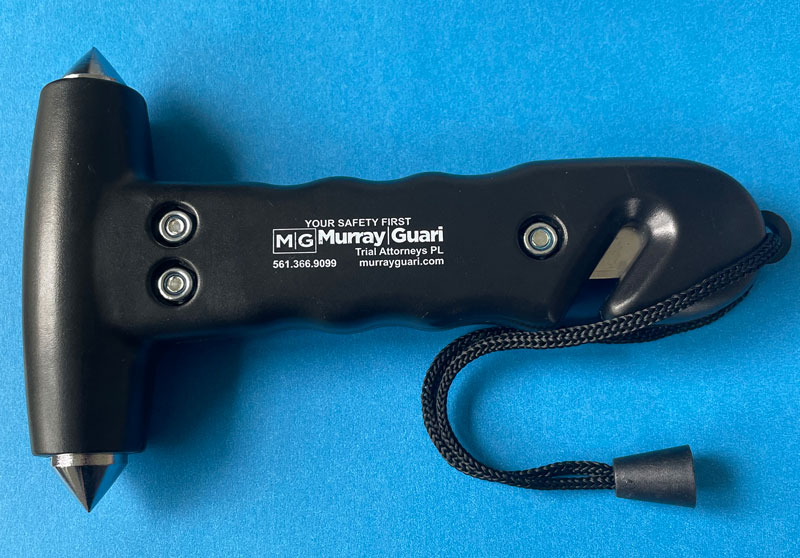Submerged Vehicle Drownings
Florida Vehicle Submersion Attorney
Entrapment and Submerged Vehicle Drowning Deaths
 Vehicle submersion accidents are horrifying with most victims surviving the initial crash with little to no injuries, only to be trapped and drown in an often overturned car. Vehicle occupants are often trapped in the vehicle unable to use the power windows due to shortage, water pressure makes the doors impossible to open and strengthen window glass cannot be broken.
Vehicle submersion accidents are horrifying with most victims surviving the initial crash with little to no injuries, only to be trapped and drown in an often overturned car. Vehicle occupants are often trapped in the vehicle unable to use the power windows due to shortage, water pressure makes the doors impossible to open and strengthen window glass cannot be broken.
University of Manitoba Professor Gordon Giesbrecht, a vehicle submersion researcher, said the most deadly type of single-vehicle accident motorists can be involved in is vehicle submersions, accounting for up to 11 percent of all drownings.
National Highway Traffic Safety Administration reports that an average more than 300 vehicle occupants die in submersion type crashes each year, Florida leads the nation in such deaths.
According to the Federal Highway Administration (FHA), Florida is one of the top 5 states to have the largest number of fatalities in crashes “where the most harmful event for the vehicle” was partially or fully being submerged in water. The FHA data shows that Florida saw the highest overall number of fatalities in crashes that involved partially or fully submerged vehicles since 2014 to 2018 with a total of 179. Florida was also one of the states to account for slightly more than half of the total drowning deaths in 48 states and D.C.
The Associated Press reports that Palm Beach County alone has 317 miles of canals. Those are just the ones supervised by the South Florida Water Management District. Many more are run by local governments, farms or private entities. And that doesn’t count natural or man-made lakes or ponds. Two of the deadliest Palm Beach County Canals are the ones parallel to State Road 80 and Floridas Turnpike.
According to the Drowning Prevention Coalition of Palm Beach County, 181 people have drowned in vehicles since 1997.
It typically takes one to two minutes for a car to fill with water, This can be a difficult situation for any person to escape, especially if they are shocked or injured. The key to survival is having a plan.
Seconds can mean the difference between life and death. Are our vehicles entrapping us, prohibiting our escape?
Vehicle Safety Features & Lack of Escape:
- Power Windows – Power windows often fail (short) once submerged with water, making exit nearly impossible.
- Laminated Glazing Versus Tempered Glass – The National Highway and Traffic Safety Administration (NHTSA), has a proposal currently in the approval process that may lead to an increase in the use of stronger glass on side windows (to prevent ejections), which some believe will make vehicle escape even harder. There is a move to use stronger laminated glazing over tempered glass – Federal Motor Vehicle Safety Standard 226 Ejection Mitigation.
- Lack of Vehicle Countermeasures – Lack of measures to improve survivability including protection of vehicle electronics, submersion sensors and mechanical backups.
- Poor Highway Design – Poorly maintained guardrails, missing guardrails or a lack of guardrails reduce your chances of survivability. Without proper guardrails vehicles can end up in water – canals, lakes, ponds, rivers the ocean and even backyard pools.
- Insufficient 911 Dispatcher Training – In taking the call, the dispatchers follow a procedure used by dispatchers nationwide (name, location and general intake). Escape instructions often come at the end of that procedure; thereby the caller drowns before help arrives.
- Lack of Warnings and Guidelines – Florida state law requires driver’s education programs to cover traffic safety laws and substance abuse, skills meant to ensure drivers stay on the road. Nonetheless, escaping a sinking car doesn’t fall within those requirements.
So what is one to do if they are submerged? In Florida, it is especially important to prepare for and practice your plan if your vehicle ends up in the Intracoastal Waterway, a canal, a lake, a retention pond, in a flash flood, or other water source.
You will need a hammer tool that will allow you to escape your vehicle, as you will most likely not able to use the door or open the windows. Look for a dual-purpose tool that not only breaks glass, but cuts seat belt webbing too. Have a center punch tool and a seat-belt cutter in your car that is easy to reach and find. Keep the tool in a place that is easy to find and reach for, like your center console,or glovebox.
Tools vary in price, but AAA recommends doing your research as their research found six commonly used seat belt cutting and window breaking tools were not able to break through the stronger glass. For your convenience, we can send you a free Automotive Escape Tool to help prepare you adn your family from an unexpected vehicle submersion. Just compete the form on this page. We hope that you will never need to use this hammer tool, but feel comfortable you have one.
Also, learn which car windows are made with tempered glass, this means it is breakable. Look for a label located in the bottom corner of each side window. The label should indicate if the glass is tempered or laminated.
To avoid panic, the escape procedure must be simple, quick, and easy to remember (POGO):
- Pop/release Seatbelt(s); release children from restraints and bring them close to an adult who can assist in their escape.
- Open or break windows.
- Get Out – children should be pushed out of the window first, and followed immediately (climb atop the car and then call for help or get to shore).
The Today Show aired a 2011 segment “Get Out Alive” – How to Survive in a Sinking Car. A Survival Systems USA instructor warned what drivers do instinctively can get them killed. They put drivers into simulators teaching them what to do if their vehicle is submerged and how to survive.
Should you witness a car plunge into a body of water call 911 and mark where the car went down (throw a rope or snap a picture) this will help first responders quickly create a search perimeter if the car sinks before they arrive.
If you or a loved one has been seriously injured or died due to a car accident or drowned in a submerged vehicle, and would like to learn more about your legal rights, please call our car accident attorneys at 561-366-9099 or contact us here.

Get a FREE Automotive
Escape Tool
Fill out the form below to get your free tool.
Recent Auto Results
Auto Accident Resources
We handle cases involving
If you or a loved one has been injured in an auto accident and would like to learn more about your legal rights, please contact us here.











